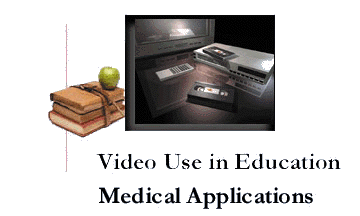
Videos for inpatients:
Patient education is slowly but surely
shifting from closed circuit television to video. Although
closed circuit television (CCTV) systems remain popular, its programming
focus is changing as patient educators realize that CCTV doesn't meet patient
needs. Today, patients stay in the hospital a shorter length of time, and
they have very specific care issues.
Barbara Giloth, manager, Patient Education Division of Ambulatory Care and Health Promotion, American Hospital Association, believes that the whole concept of how patient education is provided is changing. "We have wasted incredible resources on CCTV [programming] that makes no difference," Giloth says.
CCTV isn't being abandoned, however; hospitals have found better ways to use it. Some have dedicated channels for lighter fare, such as bingo, humor, and relaxation techniques.
Video, with its more flexible programming options, seems to hold the key to effective patient education. As Giloth notes, the greatest potential for videos in patient education centers around teaching and mastering skills.
Videos are especially useful for patients who must follow complicated regimens at home--for example, central venous catheter care. Some of the secrets to successful patient education video use, however, have yet to be unlocked. Among the challenges facing hospitals that use videos for inpatient education are scheduling and specificity.
Patient interest in health information videos is high, but when people aren't feeling well, they want to be entertained rather than educated. Yet, by the time patients do feel well enough to learn more about their medical condition, they're usually discharged.
With hospitalized patients more acutely ill than they used to be and medical tests and treatments packed into shorter hospital stays, there usually isn't much time for hospital inpatients to view videos. In fact, it's almost impossible to find a universally convenient time to air a video over CCTV. In the past, when people were customarily admitted to the hospital on the day before surgery, hospitals could show a film at 7 p.m., for example. Now, many patients are admitted the morning of surgery and released the same day or soon after, so the patient doesn't usually have the time to watch a video.
Giloth and David Stein, Ph.D., president-elect, American Society of Healthcare Education and Training (ASHET) both note that some patient educators, in an attempt to address these scheduling problems, revert to old ways. They wheel individual monitors into patients rooms and show a video when it fits into the individual patient's schedule.
Stein notes that many hospitals now have "unit" video libraries. Each unit has its own cart complete with a video monitor and VCR. A nurse/educator is assigned to work with patients. This way, although "labor intensive...is more satisfying to the nurse and the patient."
Stein is also associate professor and director, biomedical communications division, School of Allied Medical Professions, Ohio State University.

